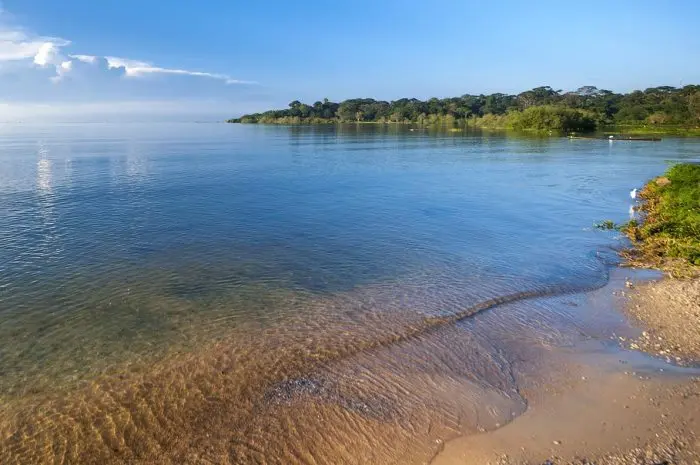Explore the pivotal role of Lake Victoria, the largest lake in Africa, in sustaining the economies of East Africa through its rich resources and vibrant ecosystems.
Lake Victoria, named after Queen Victoria by the British explorer John Hanning Speke in 1858, is an African gem that spans three countries: Uganda, Kenya, and Tanzania.
As the world’s second-largest freshwater lake by surface area, Lake Victoria is not just a geographical marvel but also a vital economic engine for the East African region.
This article delves into the multifaceted roles that Lake Victoria plays, from supporting local economies and providing critical water resources to hosting unique biodiversity and cultural significance.
Source of the Nile
One of Lake Victoria’s most renowned features is its role as the source of the Nile River, specifically the White Nile, which begins its journey at Jinja, Uganda.
The river’s outflow from Lake Victoria marks a critical point in its northward journey through Africa, culminating in the Mediterranean Sea. This connection has historical and economic significance, as the Nile has been a lifeline for civilizations for thousands of years.
The lake’s consistent water levels, regulated in part by the Nalubaale Power Station in Uganda, ensure a steady flow into the Nile, which is crucial for agriculture, drinking water, and hydroelectric power for millions of people downstream.
Fisheries and the Fishing Industry
Lake Victoria’s fisheries are vital to the local economies of the surrounding areas, employing millions of people in fishing, boat-making, and related industries.
The lake is famous for its tilapia and Nile perch, which not only feed local communities but also contribute significantly to the international fish trade.
However, the fishing industry faces challenges such as overfishing and invasive species like the Nile perch, which has disrupted native fish populations.
Efforts to implement sustainable fishing practices are critical to preserving the lake’s ecological balance and economic viability.
Agriculture and Irrigation
The fertile lands around Lake Victoria benefit from the lake’s vast watershed, which supports extensive agricultural activities.
Farmers in the lake basin grow crops such as coffee, tea, cotton, and various fruits and vegetables, which are both consumed locally and exported.
Irrigation schemes drawing water from the lake help sustain these crops, especially during dry periods. This agricultural productivity not only feeds the region but also fuels its economies through export revenues.
Water Resource for Domestic and Industrial Use
Lake Victoria is a crucial source of water for domestic and industrial use in the region. Cities and communities around the lake depend on it for their water supply, which is vital for human health and sanitation.
Additionally, industries such as breweries, textile factories, and agro-processing plants use lake water in their operations.
Managing this resource responsibly is essential to prevent pollution and ensure that the lake can continue to serve these needs indefinitely.
Biodiversity and Environmental Challenges
The lake hosts an incredible array of biodiversity, including numerous species of fish, birds, and aquatic life, some of which are endemic to its waters. This biodiversity is not only important ecologically but also adds value through eco-tourism.
However, environmental challenges such as water hyacinth invasions, pollution from industrial runoff, and climate change impacts threaten this vibrant ecosystem. Conservation efforts are crucial to mitigate these effects and protect the lake’s natural heritage.
Tourism and Recreation
Lake Victoria is a major tourist attraction, drawing visitors for activities such as boat tours, sport fishing, bird watching, and island hopping.
The lake’s islands, such as the Ssese Islands in Uganda, are popular destinations for both local and international tourists seeking relaxation and natural beauty.
Tourism not only enriches the local culture but also injects substantial revenue into the local economies.
Cultural Significance and Community Life
The lake holds deep cultural significance for the communities living around its shores. It is a source of inspiration for local myths, rituals, and ceremonies.
Communities such as the Luo, Kuria, and Jita have historical ties to the lake, with lifestyles and traditions deeply intertwined with its waters.
The lake also fosters a sense of identity and belonging, playing a central role in community life and social structures.
Hydroelectric Power Production
Lake Victoria contributes to the energy sector by supporting hydroelectric power stations, such as the Nalubaale and Kiira power stations in Uganda.
These facilities are crucial for meeting the energy needs of the East African region, providing renewable energy that supports sustainable development.
The management of water levels to facilitate electricity generation must be carefully balanced with the ecological and human needs of the lake basin.
Lake Victoria is more than just a body of water; it is a lifeline for the East African community. Its vast resources support diverse economic activities, from agriculture and fishing to tourism and energy production.
The lake’s health is directly linked to the prosperity of the region, highlighting the need for sustainable management practices that protect its environmental integrity while maximizing its economic potential.
As East Africa continues to develop, Lake Victoria will undoubtedly remain central to its ecological sustainability and economic resilience, underscoring the need for regional cooperation in its stewardship.
